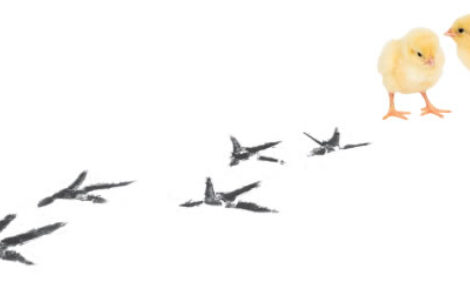



Managing Litter Moisture in Broiler Houses with Built-up Litter
Broilers can be grown very successfully on built-up litter but this requires extra effort and careful attention to address issues uncommon with new bedding, write Dr Tom Tabler (Extension Professor), Jessica Wells (Extension Instructor) and Dr Wei Zhai (Assistant Extension/Research Professor) in the Poultry Science Department of Mississippi State University.Moisture is the key factor influencing
litter quality in broiler houses. The higher
the moisture level, the longer bacteria are
able to survive in the litter. For example, in
dry litter, bacteria may survive only a few
hours or days, while in wet litter, survival
may extend up to several weeks. Therefore,
it is important to establish proper management
strategies in order to properly control
litter moisture.
The first step in this process should
begin on the day the current flock is caught
and removed from the house, before the
next flock arrives. The built-up litter on
the floor contains a large amount of heat at
the time a flock is removed. This heat can
be used to your advantage if you close the
house immediately after the flock is removed,
and use it to help dissipate moisture
and ammonia from the litter.
* "Birds grown on built-up litter are exposed to an increased number of potentially harmful microorganisms that may affect their health and performance without showing symptoms of illness or mortality" |
Many Mississippi broiler growers no
longer practise annual clean-out schedules.
This is a result of cost and availability issues
associated with new bedding materials,
along with increasing environmental
concerns over disposal of old litter. Growers
are finding it difficult or even impossible
to do a complete clean-out annually. This
has increased the need for growers to raise
birds on built-up litter.
Broilers can be grown very successfully
on built-up litter, although it requires extra
effort and careful attention to address issues
not common with new bedding, such as
caked litter and increased ammonia levels.
In addition, birds grown on built-up litter
are exposed to an increased number of potentially
harmful microorganisms that may
affect their health and performance without
showing symptoms of illness or mortality.
Weight gain and feed efficiency are two
areas that may be negatively impacted by
this increased pathogen load.
When a flock is removed from a house
for processing, it is important to condition
the litter, remove the cake, and/or windrow
the litter as soon as possible in preparation
for the next flock. Caked litter may be 40
percent or more moisture, and this moisture
must be dissipated before the next flock
arrives. Maintaining an optimum flock
environment starts with having quality litter
conditions. Ideal litter has the following
characteristics (Watkins, 2001):
- loose and not caked over
- not too dry or too wet (20 to 30 percent moisture is ideal)
- low ammonia level (less than 20 parts per million)
- uniform particle size (no large clumps), and
- minimum insect load.
Adequate minimum ventilation during
the first seven to 10 days of the flock must be
maintained to control moisture - even with
ideal litter and even when litter amendments
are used to control ammonia. Thereafter,
ventilation rates increase enough so
that excess heat removal should be adequate
to cover moisture removal needs as well.
Many broiler growers have discovered
the benefits that litter amendments provide
for controlling ammonia early in a flock.
The most commonly used amendments
contain sulphuric acid or sulphate and work by
acidifying the litter and decreasing litter pH
from more than pH7 to below pH4 during the first 10 to 14 days
of a flock. This creates a neutralizing effect
on ammonia release because most bacteria,
including those responsible for producing
ammonia, find this low pH an unfavourable
environment. Therefore, ventilation rates
can be minimal during this period because
bacterial activity and ammonia levels
remain low while litter pH is reduced.
After about 14 days, litter pH will rise again as bacterial
activity increases, but at this age, birds are large
enough that the ventilation rates should have increased
to handle moisture removal.
Maintaining proper moisture level is critical with
built-up litter, and adequate ventilation is the only
practical way to remove excess moisture. The amount
of moisture that air can hold is relative to the temperature
of the air. For example, warm air can hold much
more moisture than cold air. Cold air has most of the
moisture squeezed out of it, allowing it to cool rapidly.
Warm air is warm, in part because it is moisture-laden,
which prevents it from cooling (recall how little the
outside temperature drops overnight when conditions
are very humid and muggy).
Minimum ventilation rates for broiler houses are
based on the amount of moisture added to the house
by birds at different ages and the amount of moisture
that a given volume of air can absorb. Also, initial
temperature and moisture content (outside conditions)
and moisture-holding capacity (relative humidity) of
the air at the temperature it will be warmed to as it is
brought into the broiler house affect minimum ventilation
(Donald et al., 2009).
Table 1 lists ounces of water
in 1,000 cubic feet of air at different temperatures and
relative humidities. From this table, we can see that
40°F air at 50 per cent relative humidity contains
3.2 ounces of water; however, if the temperature is
increased to 80°F, that same air can now hold 12.2
ounces of water - almost four times as much!

(Adapted from Donald et al., 2009)
As a general rule, increasing the air temperature
by 20°fiveF doubles the moisture-holding capacity of
the air. This is what allows us to remove moisture
from the broiler house. We bring in relatively cool, dry
air from outside, heat it up so that it now holds much
more moisture than it did when it entered the house,
and remove this moisture-rich air with minimum
ventilation fans. This cycle continues every five minutes
or each time the minimum ventilation fans run.
If fan
run-time settings are adequate for the age of the bird,
then moisture build-up should not occur because more
moisture-rich air is being exhausted than pulled in. If
settings are inadequate, moisture levels may continue
to build in the house until the litter becomes saturated
and begins to slick over and form cake.
Many Mississippi broiler growers experienced this
situation during Hurricane Isaac when 14-plus inches
of rain fell over a two-day period. When outside humidity
levels are high for an extended period, it is difficult
(even if ventilation rates are increased) to maintain
house humidity levels at a desirable range. This is
because the incoming air may be just as saturated
with moisture as the air being exhausted. This situation
makes it difficult or impossible to lower humidity
levels inside the broiler house until outside conditions
improve. Often, this results in the litter caking over
before outside conditions change.
During cold weather, whenever minimum ventilation
fans run, the brooders come on shortly thereafter.
Naturally, this increases fuel costs, and growers may be tempted to reduce minimum ventilation rates; however,
this should not be considered because moisture,
carbon dioxide and ammonia levels rapidly increase in an under-ventilated
house. Maintaining normal ventilation rates,
even during cold weather, is very important. This
will improve the environment and, consequently, bird
performance, which will offset some of the additional
fuel costs.
Litter management has always been challenging,
but the increased use of built-up litter makes it an even
more difficult task. Litter that has been windrowed
must be uniformly spread back out and given at least
four to five days to finish drying before chick placement.
Partial house clean-out also presents a situation where
the litter must be levelled back out evenly throughout
the house (not just in the brooding area). Uneven litter
results in an uneven floor, and ultimately uneven feeder
and drinker lines. Birds will struggle throughout the
flock with uneven feeder and drinker lines, causing
serious management issues. For example, as birds attempt
to drink from lines that are too low, excess water
will be deposited in the litter, resulting in increased
cake formation. Uneven feeder and drinker lines also
can result in flock uniformity issues at harvest.
Summary
Managing moisture is a key factor in maintaining
ideal conditions with built-up litter.
Litter moisture
greater than about 25 per cent will result in increased
ammonia production.
Ventilation that fails to keep the
humidity level between 50 and 70 per cent will likely
lead to increased litter moisture, as well as an increased
pathogen load that is detrimental to the health, welfare,
and performance of the flock.
Be aware that litter
conditions on this flock have a carry-over effect on
litter conditions during the next flock. Also, good litter
quality at the beginning of a flock must be maintained
with management strategies throughout the flock.
The
only sure way to manage moisture levels and maintain
the quality of built-up litter is to increase continuously the ventilation rate as a flock ages to compensate for
the increasing amount of moisture added daily by the
birds.
References
Donald J., J. Campbell, G. Simpson and K. Macklin.
2009. Ten steps to drier houses and good paw quality.
National Poultry Technology Center Newsletter.
No.62, Dec. Auburn Univ. Auburn. AL.
Watkins, S. 2001. Litter conditioning for a healthy flock.
Avian Advice 3(2):10-13.
February 2013








